Author: Mark Salvo | Published: October 19, 2023 | Category: Species Spotlight
This article originally appeared in the Fall + Winter 2023 Desert Ramblings
The future of this enduring species is in our hands.
As much as we love Oregon’s high desert, it can be inhospitable at times. Summers are hot and dry. Winters can be bone chilling. To the casual observer, the landscape might appear sparse and unforgiving.
But for greater sage-grouse (Centrocercus urophasianus), this is home. In fact, the species thrives in healthy sagebrush steppe, perfectly attuned to its hardships wrought by dramatic seasonal changes. Grouse know where to find wet meadows of succulent wildflowers in late summer and flock to tall sagebrush for food and cover in cold, snowy winters.

What the species cannot tolerate is habitat loss and the erosion of ecosystem health. Sage-grouse are highly sensitive to disturbance and disruption caused by energy development, crop agriculture, residential development, livestock grazing, invasive species, off-road vehicle use, transmission lines, fencing – the list goes on.
These impacts, further exacerbated by climate change, have had a dramatic effect on sage-grouse populations. The species has suffered an 80 percent decline range-wide since 1965 and a nearly 40 percent decline since 2002. These west-wide trends are also reflected in Oregon where numbers dipped to the lowest ever recorded in 2019.
More must be done to save sage-grouse. With your support, ONDA is engaged in ambitious campaigns to protect millions of acres of public land that encompass some of the most important habitat for the species in Oregon. We have also engaged the Bureau of Land Management in a comprehensive planning process to conserve what remains of sage-grouse habitat, restrict incompatible land use and development and let grouse be grouse! The outcome of these efforts will be critical to the future of this enduring species.

